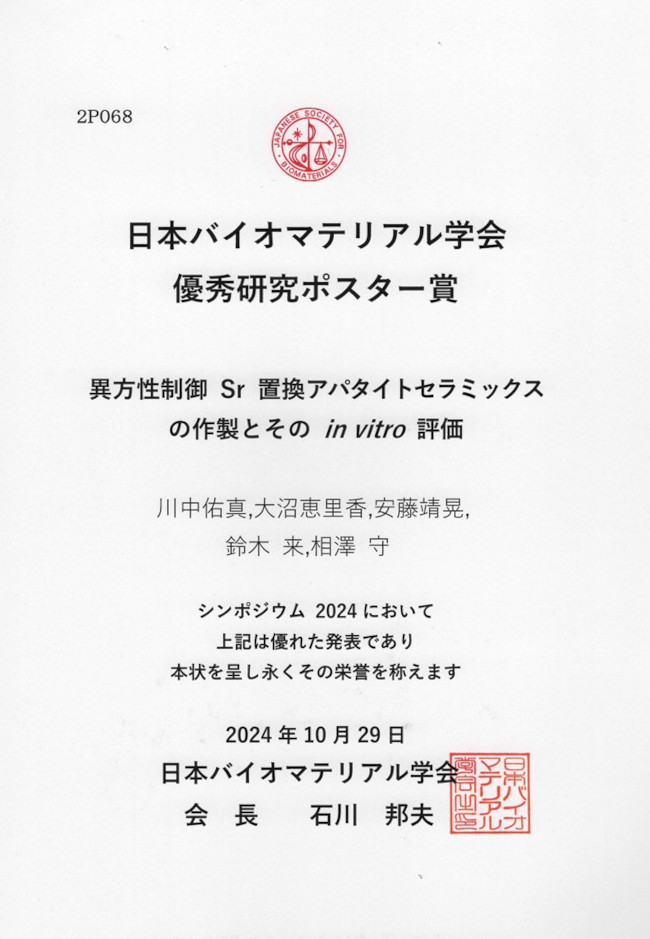[Graduate School of Science and Technology] KAWANAKA Yuma wins Best Research Poster Award at 2024 Symposium of Japanese Society for Biomaterials
Dec. 25, 2024

KAWANAKA Yuma, a second-year student of the master’s program in the Applied Chemistry Program in the Graduate School of Science and Technology (AIZAWA Laboratory, Laboratory of Biomaterials, Applied Chemistry Program), won the Best Research Poster Award at the 2024 Symposium of Japanese Society for Biomaterials!
This laboratory focuses on hydroxyapatite (HAp), which is the inorganic main component of biological bone and teeth, and is promoting basic and applied research on biomaterials that can be applied to artificial bones.
It is known that HAp has two crystal planes, a-plane and c-plane, and the a-plane (corresponding to the side of a hexagonal pencil) is positively charged and the c-plane (corresponding to the bottom of a hexagonal pencil) is negatively charged. In particular, apatite has a structure similar to biological bone on the a-side and tooth enamel on the c-side. Thus, HAp has anisotropy, and bone tissue is metabolized in biological bone by the bone remodeling process, in which osteoblasts involved in bone tissue formation and osteoclasts involved in bone tissue resorption have important roles. Also, strontium promotes bone formation by inhibiting osteoclast activity. In this research, Mr. KAWANAKA fabricated anisotropic apatite ceramics (SrHAp) with many a-plane and c-plane exposed by partially substituting strontium for HAp. In addition, osteoblasts and osteoclasts were seeded on the SrHAp ceramics, respectively, to clarify the relationship between the anisotropy of the materials and the cells.
The research results described above were highly evaluated and won the Best Poster Award at the 2024 Symposium of Japan Society of Biomaterials. The purpose of the Japanese Society for Biomaterials is to develop and improve science and technology related to biomaterials and their applications.
This research was also carried out as part of the research at the Meiji University International Institute for Materials with Life Functions.
Subject:
Fabrications of anisotropically-controlled strontium-substituted apatite ceramics and their in vitro evaluations
≪Japanese version≫This laboratory focuses on hydroxyapatite (HAp), which is the inorganic main component of biological bone and teeth, and is promoting basic and applied research on biomaterials that can be applied to artificial bones.
It is known that HAp has two crystal planes, a-plane and c-plane, and the a-plane (corresponding to the side of a hexagonal pencil) is positively charged and the c-plane (corresponding to the bottom of a hexagonal pencil) is negatively charged. In particular, apatite has a structure similar to biological bone on the a-side and tooth enamel on the c-side. Thus, HAp has anisotropy, and bone tissue is metabolized in biological bone by the bone remodeling process, in which osteoblasts involved in bone tissue formation and osteoclasts involved in bone tissue resorption have important roles. Also, strontium promotes bone formation by inhibiting osteoclast activity. In this research, Mr. KAWANAKA fabricated anisotropic apatite ceramics (SrHAp) with many a-plane and c-plane exposed by partially substituting strontium for HAp. In addition, osteoblasts and osteoclasts were seeded on the SrHAp ceramics, respectively, to clarify the relationship between the anisotropy of the materials and the cells.
The research results described above were highly evaluated and won the Best Poster Award at the 2024 Symposium of Japan Society of Biomaterials. The purpose of the Japanese Society for Biomaterials is to develop and improve science and technology related to biomaterials and their applications.
This research was also carried out as part of the research at the Meiji University International Institute for Materials with Life Functions.
Subject:
Fabrications of anisotropically-controlled strontium-substituted apatite ceramics and their in vitro evaluations
Related links


